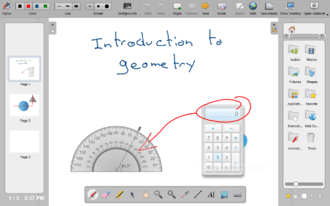Open-Sankoré
 | |
 Open-Sankoré 1.4 running on Windows 7 in full screen | |
| Developer(s) | Sankoré |
|---|---|
| Initial release | 2003 |
| Stable release | 2.0 / 20 November 2012 |
| Written in | C++, HTML, Javascript |
| Operating system | Microsoft Windows, Mac OS X, Linux |
| Available in | French, English, German, Russian, Simplified Chinese, Korean, Japanese, Portuguese, Spanish, Italian, Dutch, Swedish, Danish, Norwegian |
| Type | Interactive whiteboard |
| License | GNU General Public License, GNU Lesser General Public License |
| Website | http://open-sankore.org |
Open-Sankoré is a free and open-source interactive whiteboard software compatible with any projector and pointing device.
History
Open-Sankoré is based on the Uniboard software originally developed at the University of Lausanne, Switzerland. The software started to be developed in 2003 and was first used by the teachers of the University in October 2003. The project was later spun-off to a local startup company, Mnemis SA. It was subsequently sold to the French Public Interest Grouping for Digital Education in Africa (GIP ENA) which bought the intellectual property of the software in order to make it an open source project under the GNU Lesser General Public License (LGPL).[1]
Innovations
Beside being the first full featured Interactive Whiteboard software available in open source, Open-Sankoré brings two key innovations to the market. Firstly, its file format is non binarized and is based on the W3C web standard, therefore making it possible to be displayed in a modern web browser. This allows the content creators to distribute their lessons online without the need to install the software or a plugin. Second, the software can be extended using Apps which are written using the W3C widget standard. This allows the developers of the software to focus on the core functionality of Open-Sankoré while letting the community easily develops a wealth of more specific apps meeting their own needs.
Impact
The French government has set up an Interministerial Delegation for Digital Education in Africa (DIENA) and a Public Interest Grouping for Digital Education in Africa (GIP ENA) in order to implement a multi-year program for developing digital education in many African partner countries. Open-Sankoré is one of the strategies of this group to try to achieve the Millennium Development Goals for education in Africa, an initiative of the United Nations.[2]
Version History
Open-Sankore version 2.0
Version 2.0 (the latest version) of Open-Sankoré was released on 20 November 2012. It is compatible with Mac OS 10.6 and higher, Linux (Debian and Ubuntu 32/64bit versions), Windows XP/Vista/7 (Win8 compatibility in development), with all digital interactive tables/interactive beamers currently on the market, and with many tablets/tablet PCs.
Open-Sankore version 1.4
Version 1.4 of Open-Sankoré, released early July 2012, fixes bugs and improves performances over version 1.3 but also brings numerous new features such as new Interactivity tools to create exercises for the students to play with, online integrated search engines that allow the users to search for images, videos and sounds on Google and Planète.Sankore directly from within the software, import support for the IWB/CFF file format as well as a new text engine
See also
References
- ↑ "History". Open-Sankoré. Retrieved 26 April 2012.
- ↑ "How did the program come about?". Sankoré. Retrieved 24 January 2012.
External links
- Official website of the Open-Sankoré software
- Official website of the Sankoré program
- Open Sankoré github repositories